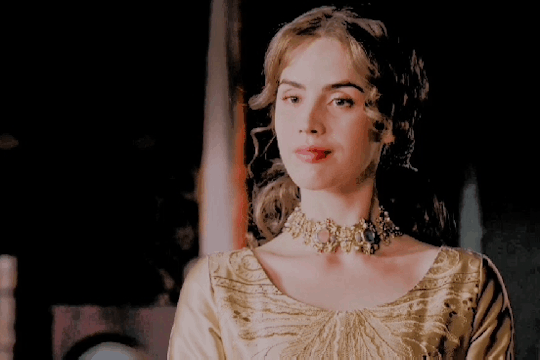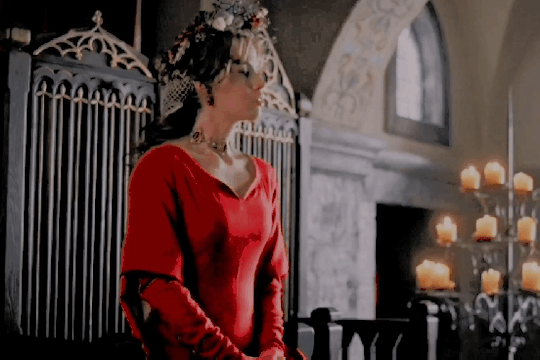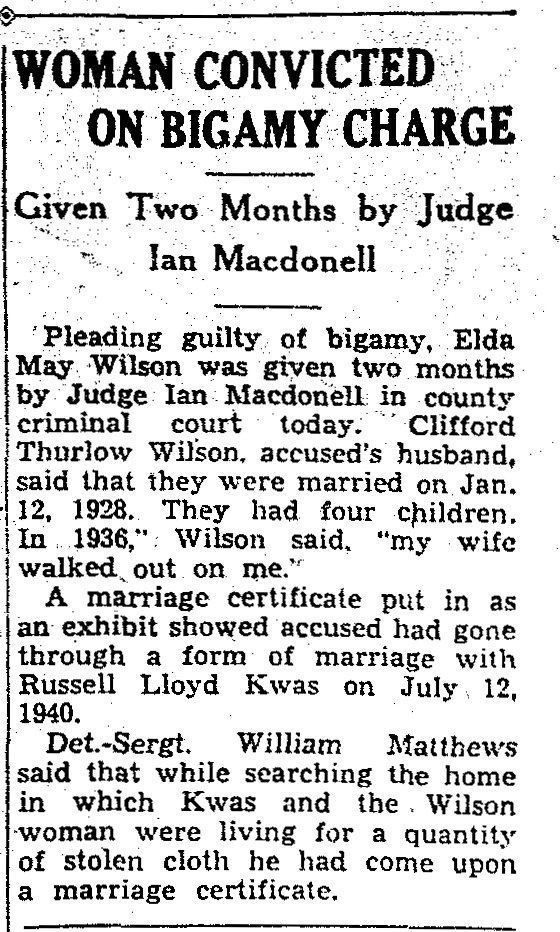#bigamous marriage
Text

"Convicted of bigamy in marrying Mrs. Frazer, of Highgate, while his previous wife was still living, Peter Schram was yesterday morning sentenced in Chatham by Judge Dowling to six years' imprisonment in Kingston penitentiary. Schram is alleged to have been thrice married."
- from the Hamilton Spectator. April 26, 1913. Page 4.
[AL: Schram was 52, from Simcoe, Ont., a stationary engineer, and had served a previous jail term for bigamy in the local jail. Schram was convict #F-599 at Kingston Penitentiary and worked in the engineer's gang. He was paroled in late 1914.]
#chatham#bigamy#bigamous marriage#small town ontario#rural crime#rural canada#regulation of marriage#marriage law#sentenced to the penitentiary#kingston penitentiary#crime and punishment in canada#history of crime and punishment in canada
1 note
·
View note
Text
"The court also provided the forum for forging alliances to further interests in the localities: the court was the obvious meeting point for the 'feminine gang of three'—Alice Chaucer, Elizabeth Talbot, and Elizabeth Woodville— to whom Colin Richmond has attributed a successful campaign to wrest two manors of the Fastolf inheritance from the Pastons and into the hands of Alice Chaucer's son, the king's brother-in-law, John de la Pole. Again this was a queenly role that usually left no evidence but its political importance must not be overlooked."
J.L. Laynesmith, "The Last Medieval Queens: English Queenship 1445-1503"
#historicwomendaily#english history#elizabeth woodville#alice chaucer#elizabeth talbot#elizabeth talbot aka eleanor talbot's sister. who would have obviously known if her sister was secretly married to the King#WHY would she be willingly allied with Elizabeth Woodville if that was actually true? she would've know that EW'e marriage was bigamous#and that her queenship was false#15th century#queenship tag#my post#queue
14 notes
·
View notes
Note
Gay/lesbian solidarity is alive and well! We are married and I'm good friends with my wife's wife and you're friends with your husband's husband!
I may not steal jewels but I do believe in this bigamous marriage!
i was about to say yes yes the lavender marriage weve all seen it but that is entirely not this situation at all JKHFDJKS my wires got CROSSED!!!! we are BEARDS!!!!!!! i also typed bears i am NOT a bear sorry to disappoint
#but also bigamous just reminds me of the word bigot. hello. bigot marriage#snail mail#would you believe me if i said i almost just typed my password in instead of snail mail. i need to be put down
0 notes
Photo

Saint Thomas More
1478-1535
Feast day: June 22 (New), July 9 (Trad)
Patronage: adopted children, civil servants, court clerks, difficult marriages, large families, politicians, lawyers, and statesmen
St. Thomas More was an English lawyer, social philosopher, author, statesman and noted Renaissance humanist. He was also a counselor to Henry VIII and Lord Chancellor from October 1529 to 16 May 1532. More opposed the Protestant Reformation, in particular, the theology of Martin Luther and William Tyndale. He also wrote Utopia, published in 1516, about the political system of an ideal and imaginary island nation. More opposed the King's separation from the Catholic Church, refusing to accept him as Supreme Head of the Church of England, and what he saw as Henry's bigamous marriage to Anne Boleyn. Tried for treason, More was convicted and beheaded.
Prints, plaques & holy cards available for purchase here: (website)
114 notes
·
View notes
Text






CHRISTINA ROKICZANA ( BEFORE 1330 — AFTER 1365
Christina was a Bohemian woman from townsfolk and daughter of Wenceslaus, mayor of Prague. At some point she was married to merchant Mikuláš Rokiczan, who unexpectedly died leaving her with great fortune. Thanks to her husband's connection with the King, she most likely became the lady-in-waiting at Bohemian court.
It was well known that King Casimir The Great is a womanizer and Charles of Luxembourg decided to use that fact to gain a spy in Polish court and possibly destabilise situation in Polish Kingdom. He invited Casimir to Prague in May 1356 and asked Christina to charm the man. It was successful, because Casimir shortly after brought her with him to Cracow. Christina, however, refused sleeping with him and becoming his mistress, what made Casimir marry her.
The problem was that he was already married with Adelaide of Hesse, which was sent away by him to Żarnowiec. She didn't agree to get a divorce, what made Casimir's marriage with Christina bigamous.
She stayed loyal to Charles of Luxembourg, stating in one of the latters they exchanged that as a Queen (although she was never crowned), she will make sure to take care of his interests and “being there [in Cracow], thanks to him, he can trust her as if they were still personally in the city of Prague”.
At some point Christina's and Casimir's relationship fell out and there are two theories about what happened — one of them says that Christina was suffering from hair loss and scabies and Casimir found out about that from one of his servants, whereas the other one says that Casimir was mad at her after Christina ordered to burn the peasant house, because it blocked a view of Wawel Castle.
It is known that Christina was still in Cracow when King Casimir married his fourth wife, Jadwiga of Sagan. According to the legend, she was burried in the garden of Łobzów residence, which Casimir builded for her.
15 notes
·
View notes
Note
TYPE: Prompt
AU: Original AU, MHA AU: Older AU
FANDOM: My Hero Academia
SUMMARY: Izuku finally proposed to his two longtime girlfriends, Ochaco and Melissa to be his lawful wives on the day he have becom the Japanese Pro.Hero #1
THEME/KINK: Marriage Proposal, Bigamy, M/F/F Threesome, Wholesome
"Ochaco Uraraka," Izuku Midoirya said as he got down on one knee, holding a small, lime box in his right hand. "Melissa Shield," Deku proceeds to open the box; revealing a pair of golden rings with diamonds on them. "Will you marry me?"
The two women gazed at their boyfriend, who they were in a bigamous relationship with. Melissa covered her lips with both hands as tears of joy swell up in her eyes, meanwhile, Ochako felt her face growing hot; similar to her early days in U.A. High. Ever since Izuku and Ochako graduated, they decided to go into hero work, joining and going up the ranks of Pro Heroes. Sometime after graduation, they met Melissa Shield once again; who not only agreed to fix both Deku and Uravity's gear but join in on their relationship. Now, Midoriya found himself as the Number One Pro Hero, becoming a Symbol of their generation of Heroes.
"Yes," Ochaco said, glomping her boyfriend with full joy. "Deku, yes!"
"Of course, Deku," the American Inventor joins in on the hug, kissing the freckled man and then the brunette's cheek. "We'll marry you!"
Izuku felt his own cheeks turning red, similar to the shade of their fellow hero Red Riot. Midoriya felt happy, with the two women he loved so much. He had to inform his mom about the proposal, who fully supported the relationship. The One for All User kissed both of his beloveds, who would soon be his wives.
#answer#answered#answer post#answer posting#answer prompt#my hero academia#boku no hero acedamia#bnha au#mha au#future au#izuku midoriya#midoriya izuku#deku#ochaco uraraka#uraraka ochako#uravity#melissa shield#izuocha#dekuravity#dekulissa#bigamy#wholesome#marriage proposal
31 notes
·
View notes
Photo


this is another element to this entire discussion is that this theory they’re pushing is not just the princes may have survived it’s the princes survived so you have to believe on on the rest of our revisionist history about richard iii, ricardian history is absolutely bizarre and contradictory and asserts everyone else behaves like a cartoon villain to prop up richard
here you have to go
richard was right and elizabeth and edward’s marriage was bigamous, therefor their children were illegitimate, if you follow this belief then this would mean even if richard and edward survived the tower they had no claim to the throne
richard knew his brother’s marriage wasn’t bigamous and usurped his nephews and put them in danger and exiled them from their family
10 notes
·
View notes
Text
"No," I insist vehemently to the haters, "Richard really did just suddenly find out that Edward's marriage was bigamous and so those kids were actually illegitimate, and that is the ONLY reason he took the throne himself. It's what was best for England, he'd never have done it otherwise. George would have done it for one of the many other reasons that make the same or more sense, but Richard? Never! Richard was hot loyal and Edward was less hot betrayed that loyalty!"
"And where did those illegitimate nephews vanish to anyway?" asks someone, reblogging my dissertation to add HATE and INTOLERANCE.
"Fuck off," I respond, not because I can't answer that one but because if I did that would just be creating the impression that the question is even worth asking. Like it's the King of England's fault if some kids who were in his care in one of his castles decided to disappear without a trace? Like the bae Richard had anything at all to gain by getting rid of the only male Yorks with a better claim to the crown than his own? Fuck off! FUCK OFFFF!!!!!
#fanwars of the roses#LEAVE RICHARD III ALONE!!!!#FUCK!!! OFF!!!!#LANCASTRIANS DNI#i'd tell george duke of clarence stans to DNI too but there aren't any (understandably as he wasn't hot)
14 notes
·
View notes
Text
So this afternoon my mum dug out the family tree research my grandparents did, to hand over to her sister when we see her, and just casually mentioned my great great something grandfather who went off to join the LDS in Salt Lake City and was never heard from again. Like that is something you just mention off-hand.
Anyway, I, being me, went digging and found his life in America, including the report of his death and his second (bigamous) marriage. Which was all very exciting until she rang her sister to tell her about it and her sister went "Yes, I know" and Mum got pissed because why the hell would you not mention that?
6 notes
·
View notes
Note
If Aegon the Conqueror took over Westeros because of the prophecy he believed in, which also claimed that the dragon has three heads, could it mean that his double marriage was also dictated by the prophecy? He needed the third head (Rhaenys) and that’s why he married both his sisters? And the rumours about marrying Visenya for duty and Rhaenys for love are false?
Anything's possible, especially with a revelation as poorly-considered as "Aegon conquered Westeros because of the prophecy." However, bigamous marriages were rare but not unheard of in Valyrian culture, so there's plenty of non-prophecy related reasons for it to be true.
He did spend 10 nights with Rhaenys for every one with Visenya, so I don't think the rumors are completely false.
But again, if the dragon has three heads, what happens when Rhaenys dies in Dorne? Does that mean the prophecy is over, thanks for playing? If it means the three heads are wrong, shouldn't that mean Aegon should be investing himself in preparing Aenys for being the next head? Because Aenys is complete and utter trash at anything relating to it.
As I've frequently said, it's just a bad revelation.
Thanks for the question, Anon.
SomethingLikeALawyer, Hand of the King
11 notes
·
View notes
Photo

“Woman Convicted On Bigamy Charge,” Toronto Star. April 22, 1941. Page 2.
----
Given Two Months by Judge Ian Macdonell
-----
Pleading guilty of bigamy, Elda May Wilson was given two months by Judge Ian Macdonnell in county criminal court today. Clifford Thurlow Wilson, accused’s husband, said that they were married on Jan. 12, 1928. They had four children. ‘In 1936,’ Wilson said, ‘my wife walked out on me.’
A marriage certificate put in as an exhibit showed accused had gone through a form of marriage with Russell Lloyd Kwas on July 12, 1940.
Det.-Sergt. William Matthews said that while searching the home in which Kwas and the Wilson woman were living for a quantity of stolen cloth he had come upon a marriage certificate.
#toronto#county police court#bigamy#bigamous marriage#regulation of marriage#marriage#marriage law#regulation of divorce#abandoning your children#runaway wife#police search#canada during world war 2#theft#crime and punishment in canada#history of crime and punishment in canada#sentenced to prison#mercer reformatory
1 note
·
View note
Note
Hi! I know it's difficult/impossible to judge the feelings of historical figures centuries after they're gone, but I always wondered why Joan of Kent chose to be buried beside her first husband Thomas Holland rather than Edward. I don't know much about her though, so I was wondering what you think about it. Thank you!
Hi! Sorry for taking so long to reply, as you'll find this is a very long reply! Joan's decision to be buried beside Thomas Holland is a very interesting one.There tends to be two main camps of through - that she chose to be buried beside Holland because she loved him "the most" or that her choice of burial location was the culmination of a deliberate policy of political obscurity that Joan had employed since the Peasants Revolt of 1381, where stories circulated that she had been attacked, and the arrival of Anne of Bohemia in 1382.
Behind the cut, I'll give an overview of the various arguments, some other possible explanations and offer my thoughts. I don't think it has to be one reason and one reason alone. People usually have a few reasons behind the major decisions they make and for a medieval noblewoman, who had a choice of locations she could choose to be buried at, the location of her burial was a major decision.
For Love
The most popular interpretation of Joan's choice is that it's a choice made from pure emotion and romance. She choses to buried beside Holland because she loved him the most. Her biographer, Penny Lawne, for instance, says that it is the "more probable" explanation for her choice:
Thomas Holand had been the great love of her life, and she wanted to be with him in death, and that this was in the end more important to her than any possible awkwardness this might cause Richard [II].
This does make a lot of sense. Medieval people believed that where and how a corpse was buried affected its condition in the afterlife, particularly during the second coming of Christ where the dead would rise from their graves. As Jessica Barker puts it, "if the dead were to be raised from their graves ... then it would follow that the person whom you lay beside would also be your companion in the Last Judgement". This suggests that Joan's choice reflected her desire to be with Holland in the afterlife.
Joan's relationship with Holland was exceptional. He was the second son of a knight, she was the granddaughter of Edward I, one of Edward III's first cousin who appears to have closely associated with Philippa of Hainault's household. Joan and Holland met, courted and married in secret. For whatever reason, it remained a secret and Joan later made a more conventional (though bigamous) marriage with William Montagu, the son of one of Edward III's favourites and eventually Earl of Salisbury. Holland later challenged the validity of Joan's marriage to Montagu via the papal courts and Joan supported his claims despite what appears to have been immense pressure not to do so, the loss of status and wealth that would result, and the possibility of alienating herself from her kin and earning the anger of Edward III. The papal courts found that her marriage to Holland was valid and annulled her second marriage, allowing her to live as Holland's wife.
The story of their relationship is extraordinary and has been hailed as one of the Middle Ages's great romances. In this context, her choice to be buried with Holland is the cherry on top, a testament to their enduring love despite the more prestigious marriage she made to the Black Prince and the twenty-five years that passed since Holland's death. It is clear by whatever metric that she still felt a strong emotional attachment to Holland.
I am very hesitant to romanticise their relationship too much. It was an extraordinary match, to be sure, but we do have to grapple with the fact that Joan was only around 12 years old when she married Holland and Holland was 24 or 25 years old, i.e. twice her age (we don't know the exact year of Joan's birth, she was born around 29 September in 1326, 1327 or 1328; Holland in 1314 or 1315). She married Holland (and their marriage was immediately consummated) by the spring of 1340, possibly in 1339. In other words, she could have only been 13 years at the most and possibly as young as 11, when she and Holland married. This, to me, looks more like a story of grooming and abuse than one of the greatest love stories of medieval England.
Obviously, Joan did feel strongly about Holland and probably did love him. Her choice to be buried with him may well have been motivated by that love, at least in part. That I read the relationship's origins as abuse does not necessarily preclude the possibility that Joan did not read it that way and that, in turn, does not necessarily preclude the possibility that it was abusive. Abuse is complicated and produces complicated responses in victims.
It doesn't necessarily follow, either, that her choice indicates that she loved Holland more than the Black Prince or was stating a preference for him over the Prince or was subtly rejecting her marriage to the Prince. By the same logic, we would need to revise the love story of John of Gaunt and Katherine Swynford to "he always loved Blanche of Lancaster more than Katherine". Both Joan and Gaunt only had one body.
The triple tomb and monument, like that of Margaret Holland, Duchess of Clarence and her husbands, John Beaufort, Earl of Somerset and Thomas, Duke of Clarence, might seem like an ideal solution but the double tomb monument was only just starting to become common in England and the triple tomb monument was never that common. Besides, the Prince's status as a war hero and the expected future king (he was even referred to as "Edward IV" in some contemporary documents), as well as his status with Joan as the parents of the currently reigning king, would make Thomas Holland's incorporation into their burial and monument unusual and I suspect be considered highly inappropriate.
For Political Obscurity
The other major line of thought is that Joan's choice of location for her tomb is part of a policy of "political obscurity" that she followed after the Peasants Revolt and Anne of Bohemia's arrival in England. Joan's status in Richard II's reign was awkward and liminal. She was the mother of the king but not, as had been the case previously, a queen in her own right. She lacked the title and authority of a queen and she never underwent the purifying and legitimising process of a coronation. While she acted as a quasi-queen in the absence of a queen and developed a reputation as a peacemaker, there is evidence that it wasn't exactly a comfortable fit.
Joan's reputation had suffered the most during Edward III's reign. Her clandestine and bigamous marriages and the ensuing scandal became public knowledge may have suggested to her contemporaries she was a headstrong, devious woman who was prone to the weaknesses inherent to her sex and wielded a certain sexual power over men. The slightly less sexist view was that that she was a giddy young girl who saw herself as acting out a courtly romance, possibly going further than she meant to. Her reputation shifted upon her marriage to the Prince towards the more sinister, where the unusualness of their match saw the surfacing of the idea that Joan had manipulated the Prince into marrying her.
This reputation was partially repaired by the way she conducted herself as Princess of Aquitaine, where the only criticism of her were complaints about her style of dress, much in the same way that clerics complain about women and fashion throughout the Middle Ages (it's basically an "old man yells at cloud" situation), and in the unstable last years of Edward III's reign and first years of Richard II's. She doubtlessly benefited from the fact that criticism was mostly focused on Alice Perrers and John of Gaunt.
But her scandalous past doesn't seem to have ever been entirely forgotten. In their accounts of Richard's deposition, both Adam of Usk and Jean Froissart report the rumours Richard was a bastard born from Joan's infidelity whose origins she deceived the Prince about. W. Mark Ormrod also argues that the story both recorded by Thomas Walsingham and Froissart that, during the Peasants Revolt of 1381, rebels broke into her bedroom in the Tower of London, broke her bed and asked her to kiss them, may have reflected a cruder story (now lost) current at the time, in which Joan was seen as "deserving" sexual victimisation because of her previous reputation. For Ormrod, Anne of Bohemia's arrival in England on the heels of these stories circulating mark the beginning of a programme of "self-effacement" and "political obscurity".
In his read, Joan's burial with Thomas Holland in the Greyfriars church in Stamford (Lincolnshire) is the culmination of this policy, where Joan effectively demoted herself from "princess to countess". Lawne, despite her claim that Joan's love for Holland inspired her choice, does seem to think there is something in this theory. The prominent placement of Edward's tomb would make Joan's also very public and she may, as Lawne suggests, have worried that her death would dredge up the controversy and infamy she had retired from court to avoid, perhaps even raising the question of the legitimacy of her marriage to Edward and thus the legitimacy of Richard's claim to the throne.
This is a tempting theory but there are uncertainties about it. Joan's retirement from court might have been less about her reputation and more about her declining health - Lawne suggests that Joan might have suffered from dropsy (edema) - or for a desire to live away from the controversies of court. She may have stepped back allow Anne of Bohemia the space to take up her role as queen and make it her own.
Joan may have also been sensitive to the fact that the last time the mother of the king had remained at court after the arrival of the new queen was during the minority of Edward III and his mother, Isabella of France, was widely condemned for her refusal to relinquish power to Philippa of Hainault, even to the point of delaying her coronation until it was an open scandal. Joan may have stepped back precisely to avoid similar condemnation rather than a desire for obscurity.
Other Reasons
Penance
Louise Tingle suggests that Joan's choice of burial may have been an act of "personal penance for her bigamous marriage". Her marriage to Holland lasted from 1340 to 1360 but nine of those years were spent in her bigamous marriage to William Montagu; thus her choice to be buried with Thomas is in some way to make up for this loss.
Preference for her Holland children
Ian Mortimer seems to suggest that Joan's choice of burial with Holland was her choosing her Holland children over Richard. I am not sure how he comes to that conclusion; none of her children chose to be buried in the same chapel. Her three surviving sons are the only beneficiaries to her will and Richard, addressed as "her very dear son", is named first and given her best bed while his Holland brothers also receive a bed each (the rest of her goods were to be sold), so she hardly shows an overt preference for her Holland children over him. We also don't know what her tomb monument looked like to know how or if she depicted her families on it.
Support for John Holland
John Holland, the younger surviving son of her first marriage, murdered Ralph Stafford shortly before her death and Richard refused to pardon him. The last recorded public act of Joan was a failed attempt to reconcile her two sons (they would reconcile after her death). It is not beyond the realm of possibility that she decided to be buried beside Thomas Holland as a gesture of support to John Holland, or as a sign of her forgiveness of him.
Location
The Black Prince intended to be buried in the chapel of Our Lady of the Undercroft in Canterbury Cathedral's crypt with Joan but at some point after his death, probably not too long after, the decision was made to bury him in the Trinity Chapel, beside the shrine to St. Thomas Beckett, one of the most popular (and the most famous) sites of pilgrimage in England. It's likely Joan was part of the group of people making these decisions at the time; others involved were likely to include Edward III, John of Gaunt, Simon Sudbury, Archbishop of Canterbury and the monks of the cathedral. Louise Tingle suggests that during her marriage to the Prince, Joan probably did plan to be buried with him in Our Lady of the Undercroft, and I'd suggest it's possible that the shift in the Prince's burial location led to Joan deciding to be buried elsewhere.
There are couple of things to note here. The first is the Prince's final resting spot was altogether a more prominent and public location which would, in turn, lead to Joan's burial being more prominent and public. If Joan had a policy of political obscurity (or even if she did not), she may have been comfortable being buried in the more obscure chapel but not in the chapel that was effectively one of the hottest tourist destinations.
Secondly, Francis Woodman suggests that the attitudes towards lay burial to Canterbury Cathedral was that it was a privilege guarded jealously and even the Archbishops of Canterbury (as members of the lay clergy) had to buy their way in. The Prince appears to have the first lay person to be buried and if burial was as restrictive as Woodman suggests, this may have meant restrictions were placed on Joan's options for burial. I wonder if she may have been allowed burial in the crypt chapel but not the Trinity Chapel and the idea of being "alone" in the crypt chapel led to her decide to be buried at Stamford with Holland. Alternatively, she may have been allowed burial in the Trinity Chapel but not with a monument or with a smaller monument than she felt befit her station so she chose to be buried in Stamford where her choice of tomb monument could be unrestricted. There have been other restrictions that lead to Joan feeling she didn't want to be buried at Canterbury Cathedral and choosing to go elsewhere.
Other Emotional Reasons
We lack historical evidence for a whole range of human experiences that Joan experienced. We don't know the intimate details of either of Joan's marriages to know whether anything happened to sway her one way or the other. This is something that history can't give us answers for but that fiction can give us possible answers.
An author might write a scene in which Holland frets that if he dies before Joan, she will marry a high-status man and forget him, she might promise to be buried with him. Another author might make something of the strains of living with someone with a chronic, debilitating illness and depict Joan choosing to be buried elsewhere out of shame at her reactions to the ill Prince.
In Anne O'Brien's novel, The Shadow Queen, Joan views the Prince's finished finished tomb and reads the epitaph on it that he personally chose. Finding its sentiments alien to her, she comes to the realisation that she never properly knew the Prince and decides that she can't be buried with him. In Juliet Dymoke's Lady of the Garter, the Prince undergoes a personality change as a result of his illness and the marriage suffers. Although Emma Campion's The Triple Knot ends with Joan's marriage to the Prince, it's clear she imagines him to be an controlling and abusive husband (he murders her puppy when he's six), and that this is the reason Joan opts for burial with Holland.
Though, I would hesitate to read Joan's relationship with the Prince as Campion does. As David Green says:
There is certainly no reason to believe that Joan’s choice of burial site was the result of a difficult relationship with Edward. Indeed, such evidence as we have suggests quite the contrary.
Some final thoughts
There doesn't have to be one singular decision as to why Joan decided to be buried with Holland over the Prince. There were probably a number of factors in play. There are two other considerations.
Firstly, it seems unlikely her decision to be buried beside Thomas Holland at the Greyfriars church in Stamford was a big shock. It seems that way to us because what evidence that survives is the Prince's will, where he intends Joan to be buried with him, and then her own will, where she says she's to be buried beside Holland. No chronicler expresses surprise or shock at her choice of burial or suggests that it had any coded message, such as disapproval of Richard II or disavowal of her final marriage.
It may have even been a decision she came to in the months between the Prince's death and his burial (he died 8 June and was buried 30 September, his funeral was 6 October). Anthony Goodman suggests that, amongst other reasons (such as the hope of Edward III recovering enough to attend), the delay may have been caused by the problems arranging the burial. If so, my own theory about the monks' reluctance to allow Joan a more prominent burial may have been one of the problems.
Her will, unlike the Prince's, leaves no detailed instructions for the construction of her tomb. The recent study of the Prince's tomb suggested that such instructions suggest no work on the Prince's tomb had begun at the time of his death. By the same logic, the lack of instructions in Joan's will, in addition to no evidence of Richard contributing to financially to it, might suggest that work had already begun (and perhaps even finished) before her death.
Secondly, so much speculation about that her tomb in part rests on the fact that it no longer exists. The Greyfriars church in Stamford and the tombs of Joan and Holland were destroyed in the Reformation. There are no records which suggest what kind of monument that Joan commissioned for herself (or others commissioned for her) or drawings or descriptions of it. As such, we have no idea what it looked like and what kind of identity she constructed for herself through it.
She may have downplayed her royal connections, her tomb reflecting the idea of her self-inflicted demotion from princess to countess as Ormrod suggested. Or it might have emphasised her status as mother of the king, Princess of Wales and Aquitaine, Duchess of Cornwall and Countess of Kent. It may have well emphasised her Holland marriage and family at the expense of her royal marriage and son or it might have emphasised her royal marriage and son at the expensive of her Holland marriage and son. It may have struck a balance between the two. We simply don't know. Even if it had survived, without any other records surviving, there is no way to know if it was Joan or her sons that determined what the tomb looked like.
References
Jessica Barker, Stone Fidelity: Marriage and Emotion in Medieval Tomb Structure (Boydell Press 2020)
Jessica Barker, Graeme McArthur & Emily Pegue "'Fully Armed in Plate of War'. Making the Effigy of the Black Prince", Burlington Magazine (November 2021)
Anthony Goodman, Joan, the Fair Maid of Kent: A Fourteenth Century Princess and her World (Boydell Press 2017)
David Green “‘A woman given to slippery ways’? The reputation of Joan, the Fair Maid of Kent”, People, Power and Identity in the Late Middle Ages: Essays in Memory of W. Mark Ormrod, eds.Gwilym Dodd, Helen Lacey, Anthony Musson (Routledge 2021)
Penny Lawne, Joan of Kent: First Princess of Wales (Amberley 2015)
Ian Mortimer, The Fears of Henry IV (Vintage 2008)
W. Mark Ormrod "In Bed with Joan of Kent: The King’s Mother and the Peasants’ Revolt" in Medieval Women: Texts and Contexts in Late Medieval Britain: Essays for Felicity Riddy, eds. Jocelyn Wogan-Browne, Rosalynn Voaden, Arlyn Diamond, Ann Hutchinson, Carol Meale, and Lesley Johnson (Brepols 2000)
Louise Tingle, Chaucer's Queens: Royal Women, Intercession, and Patronage in England, 1328–1394 (Palgrave Macmillan 2020)
Francis Woodman, "Kinship and Architectural Patronage in Late Medieval Canterbury: The Hollands, the Lady Chapel and the Empty Tomb", BAA Trans., vol. xxxv (2013)
18 notes
·
View notes
Note
If you have any I’d love recs for the childhood crush to adult lust trope! It’s so fun.
For sure!
--A Rogue by Any Other Name by Sarah MacLean. All time favorite of mine, perfect book. The hero and heroine used to write letters to each other and they're scattered throughout the novel. He got into gambling and lost his family's estate. When they meet up again, she's a part of his plans to get it back, and he's super cold and starkly different, which shocks her--forced marriage ensues.
--Ever Yours, Annabelle by Elisa Braden. Hero was the best friend of the heroine's older brother; she had a huge crush on him and he doted on her. Then she was indirectly responsible for an accident that changed his life and they separated, meeting years later when he's looking for a wife. She offers to help him find one, even though they're super into each other.
--A Scoundrel of Her Own by Stacy Reid. Reading this right now and it's very good. Hero was a poor kid, heroine was a noble lady, he saved her when she got lost and they spent a few days snowed in together. Separated by her parents upon discovery, and he's now wealthy and meets her again. He decides to become her forbidden lover~.
--When the Duke Was Wicked by Lorraine Heath. Childhood friends is a bit of a stretch because he's nine years older than her, but their parents are best friends and they grew up knowing each other. She had a childhood infatuation with him and was devastated when he married young. His wife and child end up dying, he becomes a dissolute rake and seducer. Heroine asks him to help her find a loving suitor when she becomes a debutante, he ends up licking rum off her pussy on his floor, you know how it goes. There's a lot of "Oh my Goddddd I have corrupted herrr" in this one, magnified by him having known her dad since he was super young.
--Seduce Me at Sunrise by Lisa Kleypas. Heroine is a lady, hero was a lower class growing up in her household. They were best friends and fell in love as young kids, but she got super sick and almost died; she's weak after recovering and he feels that if they get together he'll kill her with his penis (both in a crazy way and in a legit "can she survive pregnancy and birth" kind of way). He rejects her, she goes off to the continent for a couple years to get better, returns healthier, and it's ON. But he's also super self loathing so she's still gotta get her seduction on.
--Daring and the Duke by Sarah MacLean. Another childhood sweethearts one, they grew up together and fell in love young, and under some crazy circumstances he was basically pushed into... trying to... kill her. Anyway, he thought he was dead for years and is the villain of the previous two books. When he finds out she's alive he goes INSANE trying to find her and it's delicious. She makes him pay.... big time. Book-long grovel!
--A Lady at Midnight by Tessa Dare. These two were childhood friends, but she was super young and doesn't remember at first. But when he sees her again, he recognizes her and becomes her protector. Very sweet/hot.
--Rules for Engaging the Earl by Janna MacGregor. Hero and heroine were sweethearts, he goes off to war, she marries another man. When he returns he has chronic pain and a lot of shame. Her husband dies and she's pregnant; turns out the marriage was bigamous, so she needs to remarry to ensure her child isn't a bastard. Childhood friend steps in.
15 notes
·
View notes
Photo

Happy Feast Day
Saint Thomas More
1478-1535
Feast day: June 22 (New), July 9 (Trad)
Patronage: adopted children, civil servants, court clerks, difficult marriages, large families, politicians, lawyers, and statesmen,
St. Thomas More was an English lawyer, social philosopher, author, statesman and noted Renaissance humanist. He was also a counselor to Henry VIII and Lord Chancellor from October 1529 to 16 May 1532. More opposed the Protestant Reformation, in particular, the theology of Martin Luther and William Tyndale. He also wrote Utopia, published in 1516, about the political system of an ideal and imaginary island nation. More opposed the King's separation from the Catholic Church, refusing to accept him as Supreme Head of the Church of England, and what he saw as Henry's bigamous marriage to Anne Boleyn. Tried for treason, More was convicted and beheaded.
{website}
64 notes
·
View notes
Photo

Jerry Lee Lewis, who has died aged 87, achieved dazzling early success as a defining hero of rock’n’roll, when he muscled in among Elvis Presley, Little Richard and Chuck Berry, creating rock’n’roll piano from honky-tonk and hymn, as if doing so were as natural as breathing, and commandeering rhythm and blues with a casual authority achieved by no other white performer except Presley. With Whole Lotta Shakin’ Goin’ On, Great Balls of Fire and High School Confidential, he made three of the genre’s indispensable classics.
These hits, plus unbeatable versions of Mean Woman Blues, Berry’s Little Queenie and many more, shared an immediately identifiable style, an alchemy of the “Sun Studio sound”, fluid vocal brio and a pounding yet lyrical piano. Both hands were crucial in his playing, his striding left hand the foundation of the rhythm, even with a bass guitarist behind him.
Whole Lotta Shakin’ Goin’ On was his second single. Widely banned for lewdness, it sold poorly until Lewis shook up Steve Allen’s national TV show in July 1957, after which he was a star, undertaking nationwide tours while the record sold more than a million. The glorious Great Balls of Fire followed, then Breathless and the title song of the film High School Confidential, in which Lewis performed. All stormed the pop, country and R&B charts.
However, it was all to change in May 1958 when Lewis arrived in Britain. The press discovered that the 13-year-old girl with him was his wife of five months, Myra Gale Brown (who was also his third cousin). His tour was cancelled, Lewis was deported and his career under threat. Jerry confessed his whole hillbilly history: “I was a bigamist at 16 … My wife Myra and I are very happy.” The public were not.
Born in Ferriday, Louisiana, to Mary Ethel, who spoke in tongues, and Elmo Lewis, a labourer, Jerry had two sisters, Frankie Jean and Linda Gail. His elder brother, Elmo Jr, was killed by a drunk driver when they were boys. His father, imprisoned for bootlegging, was brought to the funeral in chains.
Jerry was raised in the Pentecostal church, on family gospel singing and country music by Jimmie Rodgers, Gene Autry, Hank Williams and the state’s singing governor, Jimmie Davis. He taught himself the guitar, drums and fiddle as well as the piano, and hung around a local club, Haney’s, where he claimed he heard top black performers from Duke Ellington to Muddy Waters.
At 12 he made his first paid appearance, moved on to Radio WNAT in Natchez, Mississippi, and at 13 played clubs there, while his cousin Betty Jo Slamper taught him to “smooch”.
Hired as a pianist by a travelling preacher, in February 1952 Lewis married the preacher’s 16-year-old daughter, Dorothy Barton. Jerry Lee, too, was 16. The following year he attended the Pentecostal Bible Institute in Waxahatchie, Texas. Expelled for playing gospel music “like coloured people”, he told them, rightly, that they “might as well accept it, ’cause some day that’s how it’s gonna be”. Back home in September 1953, a month before his divorce from Barton was finalised, he bigamously married a pregnant Jane Mitchum after three days’ jail for store-breaking and stealing a gun. Whether or not this second marriage was ever legalised, it ended in 1957.
In Shreveport he made two country music demos, and in Nashville sought work from Slim Whitman. But rock’n’roll was erupting across the south, and like others drawn to Sun Studios, Memphis, by Presley’s success, Lewis auditioned there. In December 1956 Sun issued Crazy Arms, which sold well despite Ray Price’s version having long been on the charts and despite Lewis sounding almost diffident (not something that would recur). The B-side, End of the Road, one of Lewis’s few compositions, was an authentic dark howl, a perfect expression of its name and place.
At year’s end Lewis played on the sessions for several other artists’ rockabilly cuts, among them Carl Perkins’s Matchbox and Billy Lee Riley’s Flyin’ Saucers Rock’n’Roll. Days later, Roy Orbison asked him to play. Lewis replied: “I don’t do sessions any more.” Later, pressed by a discographer as to who had played on Jerry Lee’s own records, he would offer one of the all-time great ripostes to the collector mentality: “I played on ’em: what the hell else d’you need to know?”
Live, he was an explosive performer in the early years, genuinely close to the edge. And uninhibitedly competitive. Resenting lower billing than Berry on a date at the Paramount Theater, Brooklyn, New York, in 1958, the rumour is that Lewis ended his act by setting the piano on fire. As they met in the wings, Lewis challenged Berry: “Follow that!” Whether or not it happened, it is a rumour Lewis himself perpetuated with glee.
Two 1964 live recordings show his genius. On a tawdry, humdrum date at the Star Club, Hamburg, playing to what sounds like about 50 people, and using, in the tradition of visiting American stars, an English backing group he met mere minutes before showtime, Lewis suddenly rose to a transcendent Your Cheating Heart, with exquisite vocal phrasing and unsurpassable piano, coursing with understatement and grace. In front of an audience of 50,000 in Birmingham, Alabama, he threw down a Hi-Heel Sneakers of shuddering, majestic excitement, stealing the song from all previous occupants.
Following his rise and fall, Lewis remained at Sun, its heaviest star, making rock’n’roll A-sides and wonderful country B-sides of the immaculate Hank Williams kind, years before country became an established new career for ex-rockers. Lewis would be a main player in opening up this route.
He regained the UK Top 10 once, in 1961, with a superb version of Ray Charles’s What’d I Say, its sumptuous thunder Sun Records’s last golden moment. Lewis left in 1962.
On record he lost direction for a time, but toured with an arrogance burnished into art, wilfully infuriating audiences of Teds by dwelling on slow country songs while provoking country crowds with unabashed rock’n’roll. In mid-song he would order a musician to “Play it, son!” only to prevent his doing so with a piano solo no one would interrupt.
For a while he joined the rock festivals circuit, including appearing at the 1969 Toronto Rock and Roll Revival, but by the 1970s he had cracked the mainstream country market with a succession of hits such as What’s Made Milwaukee Famous (Has Made a Loser Out of Me) and the impeccably wily She Still Comes Around (to Love What’s Left of Me). A rangey, muttering Me and Bobby McGee in 1971 was made “to show that damn woman [Janis Joplin] how it should be done”.
Ten years later, his skin waxy and his gait old, he combed his greased hair for the Wembley Country festival crowd, put on filthy sunglasses and delivered a consummate Over the Rainbow: the mic still placed to show off how stylishly his right hand could steer around it, his vocal control sublime. He continued to switch between the two genres for the rest of his career and, as late as October 2009, Lewis opened the Rock and Roll Hall of Fame 25th anniversary concert at Madison Square Garden in New York.
He proclaimed himself for ever a rock’n’roller, through his remaining decades of turmoil, lurid tragedy and farce. His son with Myra, Steve, drowned in their swimming pool in 1962 aged three; one of his two sons with Jane Mitchum, Jerry Lee Jr, died in a car crash at 19 in 1973; Myra divorced him, citing mental cruelty and physical abuse; in 1983 his fifth wife, Shawn Stevens, took a fatal overdose 10 weeks into their marriage, a year after his fourth wife, Jaren Pate, drowned in another swimming pool. Rolling Stone published The Strange and Mysterious Death of Mrs Jerry Lee Lewis, accusing him of murdering one wife and abusing and/or hounding to death several others.
In 1975 his plane was seized with cocaine and 11 kinds of amphetamine on board; in 1976 he was arrested outside the gates of Graceland, drunk in possession of a gun; the IRS seized his property in 1979 and 1983, and he filed for bankruptcy even as Dennis Quaid was making the 1989 Hollywood film of his life, Great Balls of Fire! A short, tax-avoiding emigration to Ireland with his sixth wife, Kerrie McCarver, and their young son, Jerry Lee Lewis III, followed in 1992.
The marriage to Kerrie, remarkably, lasted 21 years, from 1984 to 2005; in 2012 he married for the seventh time, to his former “caregiver”, Judith Brown. There had been decades of medical catastrophe, including a collapsed lung, gall-bladder removal, bleeding stomach ulcers, spinal surgery and car-crash injuries. In 1984 he was twice brought back to life in an ambulance, and had half his stomach removed in 1985, a year his wife said he also spent shooting up methadone, tranquillisers and speed. In old age he also suffered from arthritis, pneumonia and shingles, in Rick Bragg’s 2014 book Jerry Lee Lewis: His Story.
Lewis embodied pinched obduracy, brooding, malevolent ignorance, violent unreliability and borderline madness. He abused women, played with guns and shot at men; he drove the highways of the south blind drunk with his loaded pistol on the dashboard. Yet in the vivid contrast between the meanness of the man and the grandeur of the artist, the common denominators were his phenomenal energy and admirable, all-conquering self-belief.
He will be remembered for his lifetime of hillbilly delirium, but he will be renowned for his seizure of the musical moment at the dawn of rock’n’roll, when an incomparable talent was his intoxicant and ours: when he shot up the old order and played out his defiant dramas on the keyboard, in the studio and on the stage.
He is survived by Judith, and his children Ronnie, Phoebe, Lori and Jerry Lee III.
🔔 Jerry Lee Lewis, singer, songwriter, pianist and guitarist, born 29 September 1935; died 28 October 2022
Daily inspiration. Discover more photos at http://justforbooks.tumblr.com
25 notes
·
View notes
Text
Obligatory disclaimer that no one is ever entitled to a crown and that the Iron Throne has only ever made everyone around it miserable, but it is so funny to me that since HOTD retconned Laenor's death, he and Rhaenyra are technically still married which makes her and Daemon's marriage bigamous and unlawful in Westerosi society, consequently making their children bastards. Which means that at the end of the Dance, the people with the actual closest legitimate blood claim to the throne are- my gods, what's this? It's Baela and Rhaena with a steel chair!
#hotd#oh to be a fly on the wall in targ hell when they realize this#rhaenys is not exactly pleased because the iron throne has only ever killed everyone she loves#but she does sideeye jaehaerys i with something close to a grim 'ha'#she tells corlys when he finally joins her and he howls with laughter for the next century#daemon and alysanne are both on the fiery ground crying because they're cackling so hard#daemon because after all those years of people saying he was after the throne#his daughters are quite unintentionally the most legitimate heirs#while alysanne is vindicated. it's not a joyous vindication but she will hold this over jaehaerys forever.#laena is not laughing because she's busy giving aemond the coldest; most unimpressed look#'you could have flown ANYWHERE with vhagar but you used her like a weapon and crashed her in a lake'
3 notes
·
View notes